No products in the cart.
Outdoor Adventure
5 Exercises for the Ultimate Off-Season Ski Workout
Heading out the door? Read this article on the new Outside+ app available now on iOS devices for members!
Download the app.
For skiers, the off-season is a time to balance fun summer activities, rest, and training. (And, yes, this principle still applies even if you’re still hitting the slopes this August.)
When you’re off the snow, your training should focus on building body awareness, control, strength, coordination, and mobility. By doing so, you’ll develop a solid foundation that will help prevent pain and injuries on the slopes.
Here, I’ll break down how to assess your current strength and offer five exercises to add to your off-season ski workout to start next winter off at your strongest.
Test Your Strength for Ski Season With a Side Plank
This test may seem simple—but that doesn’t mean it isn’t helpful. By doing this exercise, you’ll observe the strength (or lack thereof) in your hips, trunk, and core. Your obliques and hips allow you to rotate and stabilize while moving through different types of terrain. Weakness in these areas can increase your risk of back, hip, and knee pain on (and off) the slopes.
How to Do the Side Plank Test
Lay on your side. Position your elbow under your shoulder. Stack your legs on top of each other. Lift your hips off the floor and push them forward. Your body should create a straight line from your head to your toes. Flex your top foot and lift it to hip height. Hold for a second. Slowly lower it back down.
Stop the test when your shoulder collapses, your hips sag toward the floor, or your body is no longer stacked. A skier is typically able to complete five lifts a side before losing their form. Your goal for this exercise is to complete 10 to 15 reps on each leg.
5 Exercises for an Effective Off-Season Ski Workout
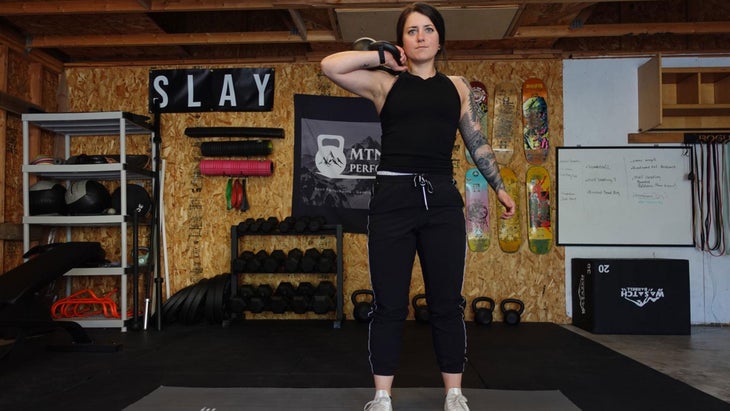
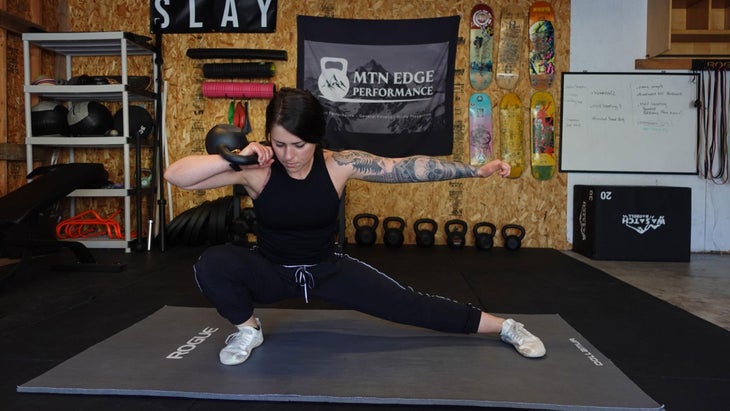
1. Lateral Lunges
When it comes to lunges, this lateral variation is helpful for building robust hip strength, which is key if you want to ski pain-free and feel strong while charging down the mountain.
How to do it:
- Take a wide step to the side with your left foot.
- Push your hips back to lower toward the ground.
- As you sit back, bend your right knee and drive it away from your body. Straighten your left leg. All of your toes should face forward.
- Push away from the floor with power to return to the starting position.
You can either alternate sides or remain on one side for all of your reps before switching. Aim to complete eight to 12 reps on each side.
If you want to increase the difficulty of the exercise, hold a weight at your chest. Advanced practitioners can also move with a kettlebell in a front rack position.

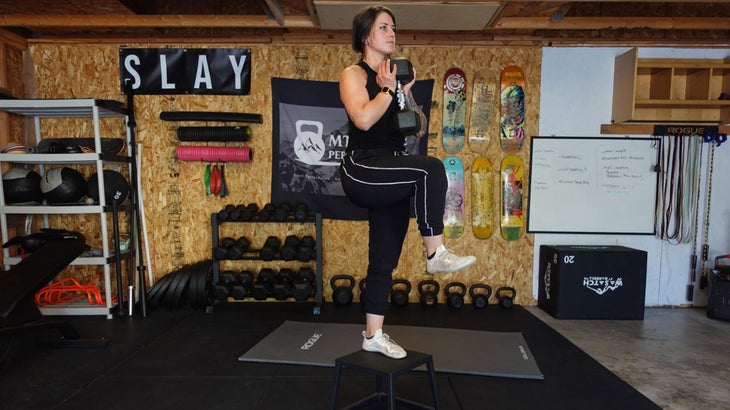
2. Step-Ups
Step-ups strengthen your glutes, hamstrings, and quads. They also improve your single-leg stability, eliminate strength imbalances, and build explosive power. Adding this exercise into off-season workouts will make your turns on the hill even more powerful.
For this move, you’ll need a box, bench, or step at shin or knee height.
How to do it:
- Plant your left foot on the box.
- Drive through your left leg and step up with your right leg.
- Hover your right knee in the air at a 90-degree angle. Squeeze your left glute. Hold this position for 3 to 5 seconds.
- Slowly step back down.
Complete eight to 12 reps on one side before switching to the other leg. To advance this movement, hold a weight at your chest throughout the exercise.
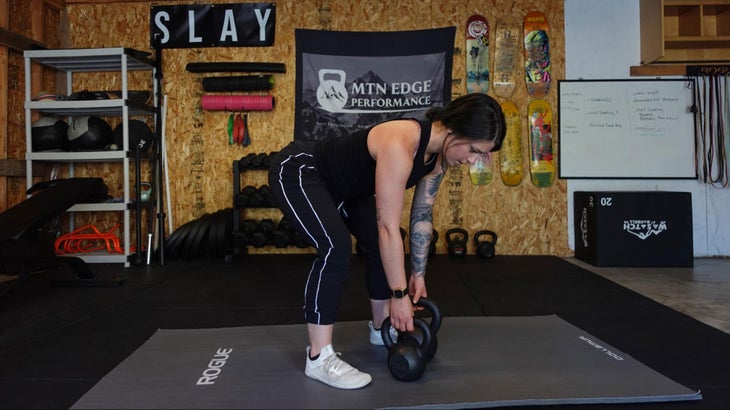
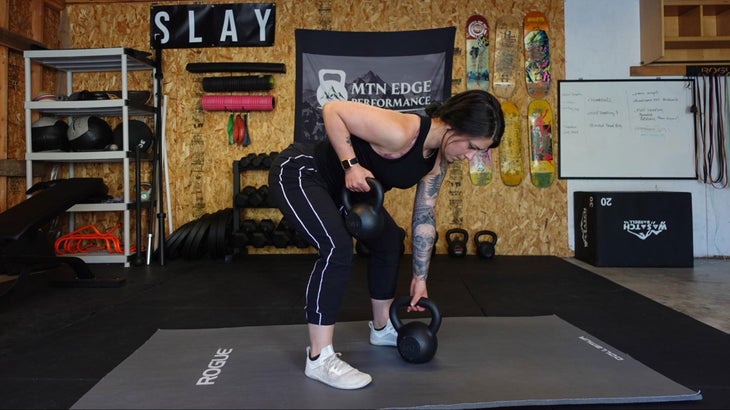

3. Gorilla Row
When it comes to off-season ski workouts, I love integrating any type of row into my training. However, this variation, the Gorilla Row, is my current favorite. This movement targets your lower back, core, and erector spinae muscles. These latter muscles in your deep back absorb the impact of charging downhill or landing from jumps.
For this move, you’ll need a set of kettlebells.
How to do it:
- Stand with your feet about hip-width apart with the kettlebells between your feet.
- Hinge from your waist. Bend your knees to reach the kettlebell handles. Hold one in each hand.
- Keep your back flat and your hips down. Contract your core, as you pull your elbows back toward your hips.
- Lower the weight back to the starting position before beginning the next rep.
You can alternate kettlebells or row them at the same time for an added challenge. Complete eight to 12 reps on each side.

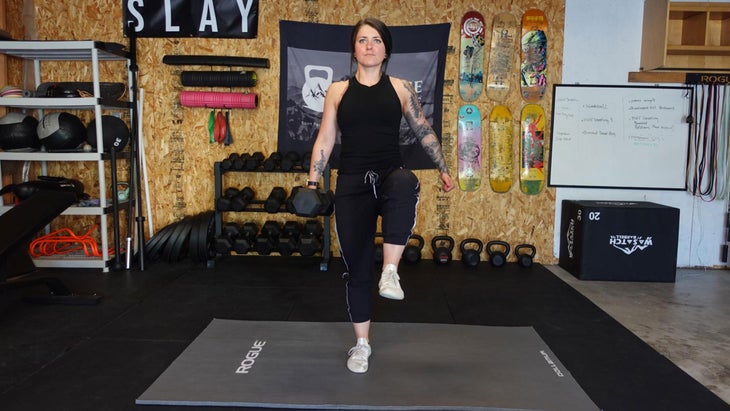
4. Suitcase March
This core exercise strengthens the deep stabilizer muscles that support side-to-side movements on the mountain. Add it into your off-season ski workout to be able to carve, drop, and charge down the mountain without back pain.
For this move, you’ll need one medium or heavy dumbbell.
How to do it:
- Stand tall through your torso. Hold your dumbbell with your right hand, slightly off your right hip.
- Raise your left knee to a 90-degree position. Squeeze your left glute. Lower the left leg back down.
- Continue to lift and lower the left leg, marching in place. Look straight ahead.
Complete two to four sets of 30 to 60 seconds per side.
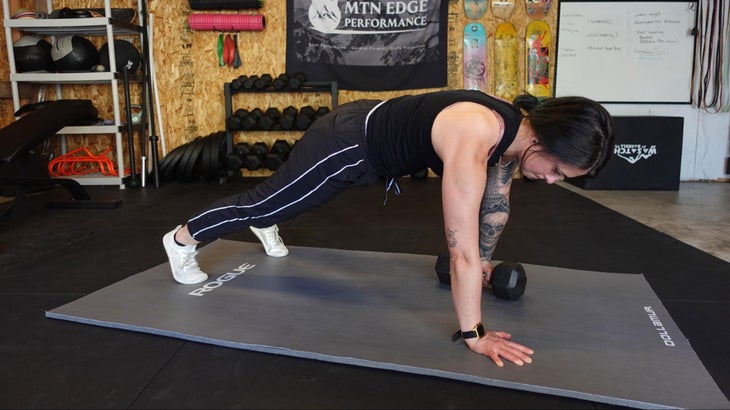
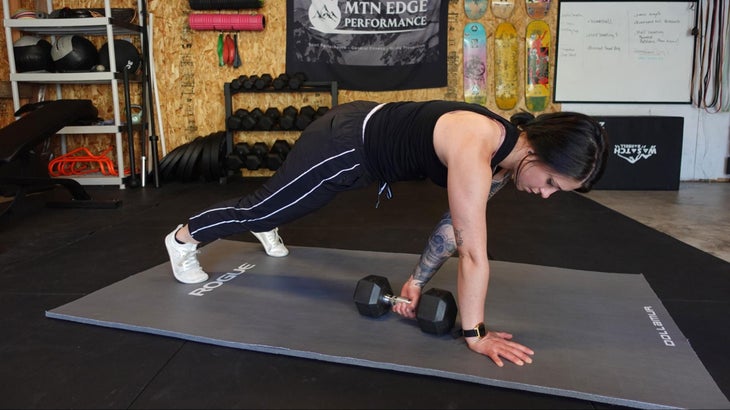
5. Plank Pull-Through
This plank variation will challenge your core stability. When you’re chasing powder, your abs help steady your body and respond to changing conditions.
For this move, you’ll need one medium or heavy dumbbell.
How to do it:
- Set up in a high plank position with your wrists directly under your shoulders.
- Contract your core. Actively push away from the floor with one hand. Pull your weight across your body with the other hand.
- Alternate sides, moving the weight back and forth between your arms. Keep your hips stable throughout this movement. Try to avoid twisting or rotating.
Complete two to four sets of 30 to 50 seconds.

